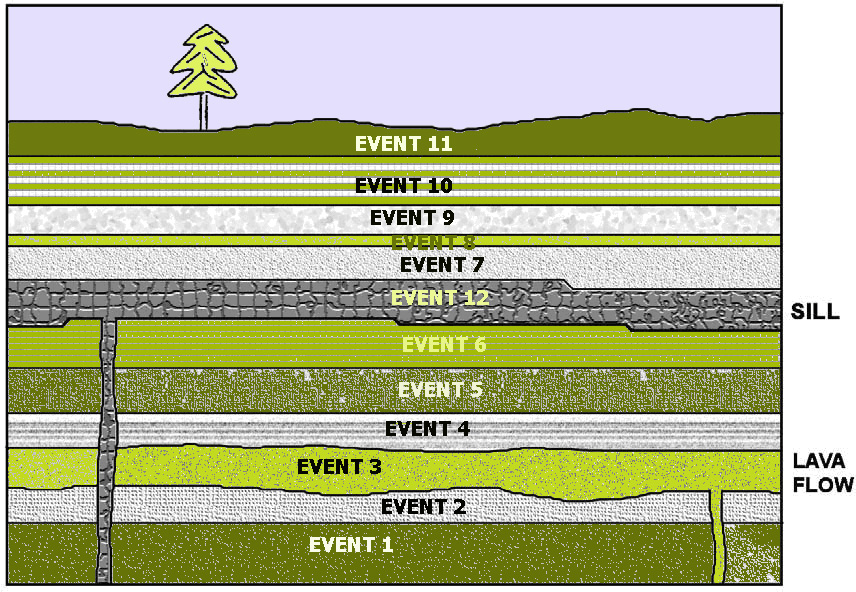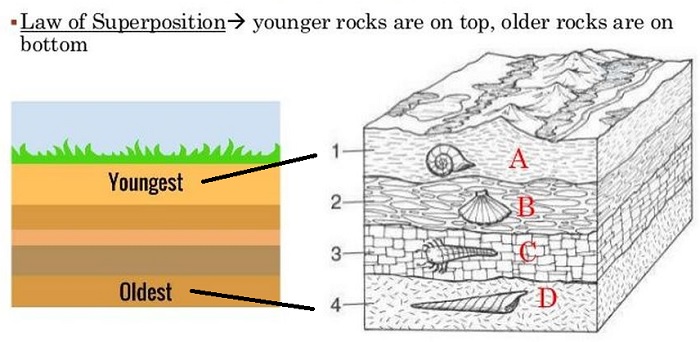|
ROCKS
|
||||
|
Authors: David Seidemann and David Leveson Edited for the web: Guillermo Rocha |
||||
|
Many aspects of rock origins are best understood if a rock is considered in terms of its relationships with its neighbors. Such relationships are best seen 'in the field', where the rock is in its natural setting. As an example of this approach, we will consider several field situations to see what light they shed on the origin of rocks. |
||||
|
Age Relationships of Layered Rocks - Geologists quantify the immense time spans involved in earth history by establishing a reference point in time, and then counting backwards from that reference point using convenient time units. Geologists use the modem era as a reference point and reckon time backwards to the time of occurrence of a geologic event, as for example, the formation of a rock. Thus, to say that a sandstone is 100 million years old means that 100 million years ago, that sandstone was in the process of formation, perhaps as a sandy beach along an ancient coastline. This is a familiar approach because it is essentially the same as we take in dealing with everyday life. The major difference is that we use different time units (weeks, days, minutes) to measure the short time scales characterizing our day-to-day affairs. |
||||
|
Geologists can determine the relative ages of the layers in a sequence of layered rocks from the positions of the sedimentary layers in the sequence. Generally, a given sedimentary layer is younger than (i.e. formed more recently) the sedimentary layer below it and older than (i.e. formed before) the sedimentary layer above it. This idea is referred to as the Principle of Superposition. |
||||
|
|
||||
|
Lava Flow: An igneous layer may be a lava flow which was erupted onto the earth's surface from a volcanic vent. The flowing lava covered the sedimentary rock layers beneath it. At a later time, after the lava had cooled and turned to rock, it was buried by a new influx of sediment, thus becoming part of the layered sequence. |
||||
|
Sill: Molten rock, working its way upward through the layered sequence, did not reach the surface of the earth. Instead, while still below ground level, it wedged, or intruded, itself laterally between two of the sedimentary layers in the sequence, where it eventually cooled and became a rock. This intrusive body, called a sill, thus became part of the layered sequence. |
||||
|
Is the lava flow older or younger than the rocks that are… |
||||
|
…immediately above it?: _________________________ |
||||
|
…beneath it?: _________________________ |
||||
|
Is the sill older or younger than the rocks that are immediately… |
||||
|
…above it?: _________________________ |
||||
|
…beneath it?: _________________________ |
||||
 |
||||
|
THE THREE TYPES OF ROCKS General concepts about the three types of rocks. |
||||
|
IGNEOUS ROCKS - Igneous rocks are made of the solidification of lava (molten material cooled outside on the Earth's surface) and solidification of magma (molten material cooled at depth and underneath the Earth's surface). |
||||
|
SEDIMENTARY ROCKS - Sedimentary rocks are made of clasts (pieces) of other rocks that were dewatered, compacted and cemented together. Other sedimentary rocks are made of remnants of plants/animals and also by the precipitation of chemicals that saturated water bodies. |
||||
|
METAMORPHIC ROCKS - Metamorphic are rocks (igneous, sedimentary, or metamorphic) that have been changed due to heat and pressure. |
||||
|
The rocks cycle is a set of crustal processes that forms new rocks (IGNEOUS), modifies rocks (METAMORPHIC), breaks and transports rocks (SEDIMENTARY). |
||||
©Guillermo Rocha/Brooklyn College
